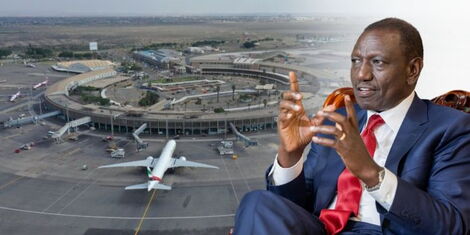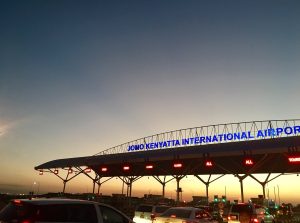Development
Kenya Set To Unveil New Strategy for JKIA Expansion Before the End of the Year
Kenya Airports Authority (KAA) has identified several priority areas requiring immediate attention, including runway upgrades, airside access roads, and the baggage handling system.

Government pivots to alternative funding after Adani deal cancellation as passenger numbers surge beyond capacity
Kenya’s government is racing against time to launch a comprehensive expansion of Jomo Kenyatta International Airport (JKIA) before December 31, marking a crucial turnaround after the controversial collapse of the Adani Group partnership eight months ago.
Transport Cabinet Secretary Davis Chirchir announced the ambitious timeline during recent stakeholder meetings, emphasizing the urgency of addressing JKIA’s infrastructure crisis. “We are really conscious about this. Remember our airport got burnt and is in a tent, and so we are really conscious and we are working round the clock to see that on a very tight timeline whether we can break ground before the end of this year,” Chirchir stated.
The announcement comes 229 days after President William Ruto terminated the controversial airport deal with Indian conglomerate Adani Group in November 2024, following public outcry over secretive contract clauses and transparency concerns.
The cancellation forced the Ministry of Transport to explore alternative financing mechanisms for the capital-intensive project.
The expansion has become increasingly critical as JKIA struggles with overwhelming passenger traffic.
The airport recorded 8.75 million passengers in 2024, representing a 6.6 percent increase that pushed operations 1.25 million passengers beyond its 7.5 million capacity threshold.
This surge has exposed the limitations of the facility’s aging infrastructure and single runway system.
Kenya Airports Authority (KAA) has identified several priority areas requiring immediate attention, including runway upgrades, airside access roads, and the baggage handling system.
During a high-level meeting with ground handling agents on July 9, KAA Board Chairman Caleb Kositany committed to leveraging the authority’s financial resources to accelerate infrastructure development.
New Funding Strategy Emerges
The government has pivoted to a multi-partner approach, engaging with various development financial institutions including the European Investment Bank, KfW, the French Development Bank, Japan International Cooperation Agency (JICA), Abu Dhabi Fund for Development, and China Exim Bank. Officials are currently awaiting feedback on proposals to fund the redevelopment using JKIA’s balance sheet.
This strategy represents a significant shift from the previous public-private partnership model with Adani, which would have transferred operational control to the Indian firm.
The new approach maintains government oversight while tapping into international development finance.
Beyond infrastructure concerns, the expansion serves broader economic objectives.
Cabinet Secretary Chirchir emphasized Kenya’s position as the fourth-largest flower producer globally, noting that denying airline frequencies into Nairobi would harm both tourism and export revenues.
The government argues that enhanced airport capacity will attract more airlines to the Kenyan capital, facilitating partnerships for the national carrier.
Aviation and Aerospace Development Principal Secretary Terry Mbaika challenged Kenya Airways to “continue to reinvest in its business model, make the best of its positioning on key routes, and consider partnerships that will contribute to the overall business.”
Infrastructure Investments Begin
While the major expansion awaits groundbreaking, KAA has already initiated several upgrades.
The authority recently invested in a new generation aircraft recovery system to handle stalled aircraft at the facility’s sole runway, addressing operational bottlenecks that have plagued the airport.
The government’s commitment to breaking ground before year-end reflects both the urgency of JKIA’s infrastructure needs and political pressure to demonstrate progress following the Adani debacle.
With passenger numbers continuing to grow and regional competition intensifying, the success of this timeline will be crucial for Kenya’s aviation sector and broader economic aspirations.
As the December deadline approaches, stakeholders across the aviation industry are watching closely to see whether the government can deliver on its ambitious promise to transform East Africa’s busiest airport into a modern, competitive facility capable of handling future growth.
Kenya Insights allows guest blogging, if you want to be published on Kenya’s most authoritative and accurate blog, have an expose, news TIPS, story angles, human interest stories, drop us an email on [email protected] or via Telegram
-

 Business2 weeks ago
Business2 weeks ago‘They’re Criminals,’ Popular Radio Presenter Rapcha The Sayantist Accuses Electric Bike Firm Spiro of Fraudulent Practices
-

 Business1 week ago
Business1 week agoIt’s a Carbon Trading Firm: What Kenyans Need to Know About Spiro’s Business Model Amid Damning Allegations of Predatory Lending
-

 Business1 week ago
Business1 week agoManager Flees Safaricom-Linked Sacco As Fears Of Investors Losing Savings Becomes Imminent
-

 News1 week ago
News1 week agoWoman Accused in High Defamation Blames AI As Case Exposes How Mombasa Billionaire Mohamed Jaffer Allegedly Sponsored Smear Campaign Linking Joho’s Family To Drug Trafficking
-

 Investigations2 weeks ago
Investigations2 weeks agoDisgraced Kuscco Boss Arnold Munene Moves To Gag Media After Expose Linking Him To Alleged Sh1.7 Billion Fraud
-

 Africa2 weeks ago
Africa2 weeks agoDisgraced Oil Trader Idris Taha Sneaks Into Juba as Empire Crumbles
-

 Investigations2 weeks ago
Investigations2 weeks agoFraud: How Sh235 Million Donor Cash For Nyamira Residents Was Embezzled Through Equity Bank Under Governor Nyaribo’s Watch
-

 Investigations1 week ago
Investigations1 week agoIntelligence Report Links Budding Politician James Mabele Magio To International Scammers Ring











